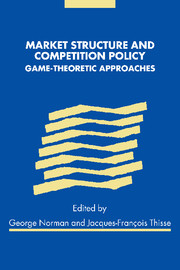Book contents
- Frontmatter
- Contents
- List of figures
- List of tables
- List of contributors
- Louis Phlips: a brief biography
- Introduction
- 1 Competition policy and game-theory: reflections based on the cement industry case
- 2 Legal standards and economic analysis of collusion in EC competition policy
- 3 A guided tour of the Folk Theorem
- 4 Predatory pricing and anti-dumping
- 5 Should pricing policies be regulated when firms may tacitly collude?
- 6 Tougher price competition or lower concentration: a trade-off for anti-trust authorities?
- 7 The strategic effects of supply guarantees: the raincheck game
- 8 Product market competition policy and technological performance
- 9 On some issues in the theory of competition in regulated markets
- 10 Modelling the entry and exit process in dynamic competition: an introduction to repeated-commitment models
- 11 Coordination failures in the Cournot approach to deregulated bank competition
- 12 How the adoption of a new technology is affected by the interaction between labour and product markets
- Index
12 - How the adoption of a new technology is affected by the interaction between labour and product markets
Published online by Cambridge University Press: 22 September 2009
- Frontmatter
- Contents
- List of figures
- List of tables
- List of contributors
- Louis Phlips: a brief biography
- Introduction
- 1 Competition policy and game-theory: reflections based on the cement industry case
- 2 Legal standards and economic analysis of collusion in EC competition policy
- 3 A guided tour of the Folk Theorem
- 4 Predatory pricing and anti-dumping
- 5 Should pricing policies be regulated when firms may tacitly collude?
- 6 Tougher price competition or lower concentration: a trade-off for anti-trust authorities?
- 7 The strategic effects of supply guarantees: the raincheck game
- 8 Product market competition policy and technological performance
- 9 On some issues in the theory of competition in regulated markets
- 10 Modelling the entry and exit process in dynamic competition: an introduction to repeated-commitment models
- 11 Coordination failures in the Cournot approach to deregulated bank competition
- 12 How the adoption of a new technology is affected by the interaction between labour and product markets
- Index
Summary
Introduction
It is commonly observed that firms in a given industry often use different technologies. Many explanations can be given such as the history of each firm, the existence of patents and licences or differences in skilled labour availability. These differences are often considered as exogenous in the industrial organisation literature although, at some point, they must result from firms' decisions. What should be clear, however, is that the use of different technologies directly affects the degree of competition in a given industry. In particular, equilibrium concentration is likely to reflect technological asymmetries so that the fact that some firms persist in using less efficient technologies could be viewed as a way to alleviate competition.
It has been argued that the adoption of different technologies may reflect strategic considerations. For example, in a completely symmetric environment, Mills and Smith (1996) show that the implications of technological choices at the product-competition stage may induce firms to choose different technologies. They consider a two-stage game in which firms pre-commit to technological choices in the first stage and compete in quantities in the second. They define particular technologies as specific combinations of fixed costs and constant marginal costs, a low marginal cost being associated with a larger fixed cost. In this context, once a firm has chosen the low-marginal-cost technology, the other firm may be better off choosing the high-marginal-cost technology and save on fixed costs. This leads to heterogeneous technological choices, and thus to a higher industry concentration in equilibrium.
- Type
- Chapter
- Information
- Market Structure and Competition PolicyGame-Theoretic Approaches, pp. 271 - 286Publisher: Cambridge University PressPrint publication year: 2000
- 3
- Cited by



